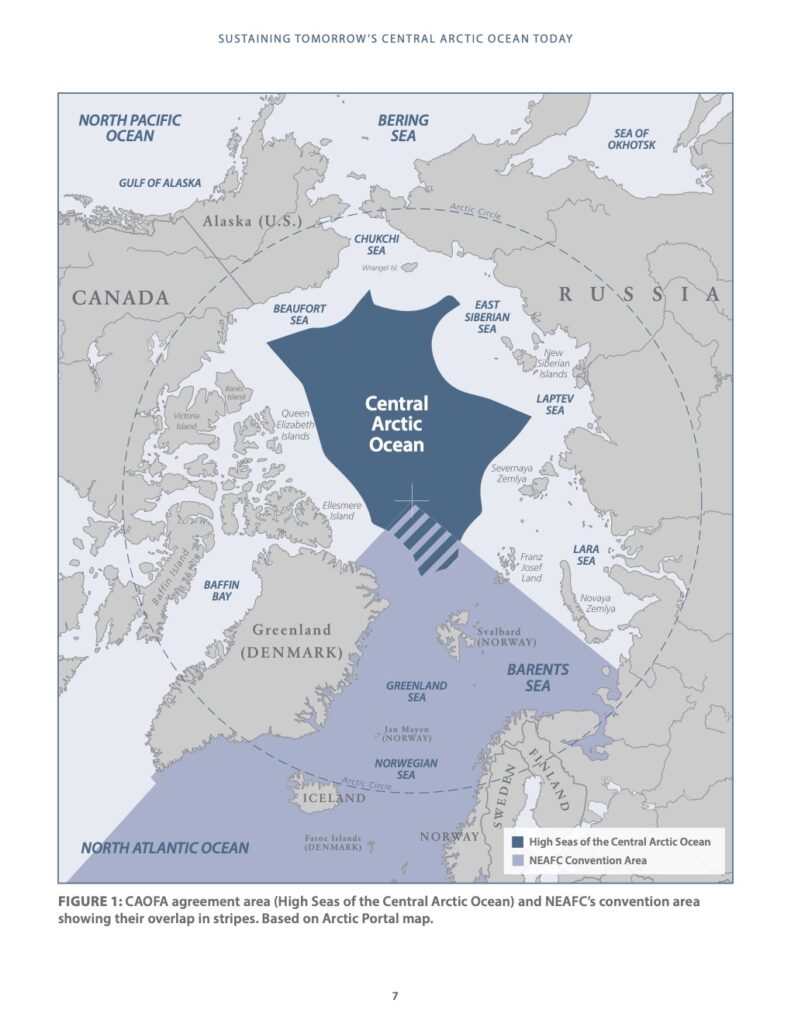© McDonald Mirabile / WWF-US
Features
The Central Arctic Ocean Fisheries Agreement – what it is, is not and might be
- ArcNet
- Biodiversity and nature
- Central Arctic Ocean Fishing Agreement
- Governance
- Pan-Arctic
Currently, there are no fisheries in the high seas of the Central Arctic Ocean (CAO). Still, there is an important conservation success story to be told about fisheries here: The Central Arctic Ocean Fisheries Agreement (CAOFA). But what is it? And what can we expect from the agreement?
With sea ice in the region melting fast, the CAO ecosystem and food web are becoming accessible to scientists and industry alike. Historically, industries have rushed to harvest new resources. But the case of the CAO high seas is thus far different.
In October 2018, ten parties (Canada, China, Denmark for the Faroe Islands and Greenland, the European Union, Iceland, Japan, Norway, Russia, South Korea and the United States) signed the CAOFA. It came into effect in June 2021, starting a 16-year ban on commercial fishing.
This ban on commercial fishing will allow scientists time to better understand the CAO ecosystem and advise whether the region can sustain a certain amount and type of commercial fishing activities – or not.
At the Arctic Circle Assembly this past October, David A. Balton, Executive Director of the Arctic Executive Steering Committee at the White House Office of Science and Technology Policy, presented his take on CAOFA. Balton chaired the negotiations of the CAOFA text between 2015 and November 2017, when agreement on the text was reached. In this panel discussion, he spoke alongside WWF Global Arctic Programme Director Vicki Lee Wallgren.
In his talk, Balton highlights: Two things that CAOFA is, two things it is not and one thing it might be.
We outline his presentation below, as well as explain WWF Global Arctic Programme’s role as an observer to CAOFA.
What CAOFA is
1. The precautionary approach in action
The precautionary approach errs on the side of caution. When scientific knowledge is lacking, the approach emphasizes caution until more is available.
In his talk, Balton describes CAOFA as the best example in international law of the precautionary approach in action.
CAOFA being created and ratified by nine nations and the EU effectively prevented commercial fishing from taking place before scientists could understand the ecosystem dynamics. It has created a scientific monitoring and research program that will allow scientists to learn the state of the ecosystem.
It is a conservation story to celebrate in the Arctic, and even beyond the region. It is a story of cooperation and acting to prevent an environmental crisis instead of acting in response to it.
2. Indigenous knowledge and a binding international agreement
The inclusion of Indigenous knowledge is written into CAOFA. It states that Indigenous Peoples must be part of its implementation.
Like the UNFCCC Paris Agreement, CAOFA is a legally binding agreement among the ten parties.
In the Arctic, Balton explains that this is one of the best examples of a legally binding agreement. It was made possible by Indigenous Peoples, Canada, Russia and the United States initially coming to the table and successfully negotiating for Indigenous inclusion and a legally binding agreement.
What CAOFA is not
1. It is not a panacea
Despite CAOFA being an important step for conserving the CAO ecosystem, it is not a panacea to all problems in the Arctic high seas.
It prohibits one specific human activity – unregulated commercial fishing – in one specific area of the Arctic Ocean – the high seas portion of the CAO.
But it will not solve problems beyond commercial fishing activities, such as climate change and its implications, or other forms of economic exploitation of this part of the Arctic Ocean.
2. It is not permanent
Initially, CAOFA will last for 16 years starting from the date it went into force in June 2021. After that, it will be extended automatically in five-year increments unless any of the signing Parties objects to the extension.
This means that this area can still be exposed to commercial fishing activities in the future, regardless of what emerges from the scientific findings.
What CAOFA might be
A model for other international agreements
Diplomacy between Indigenous Peoples, Arctic nations, non-Arctic nations and the EU in establishing CAOFA is something to highlight.
Approaching the issue of commercial fishing in the Arctic with precaution and establishing an agreement that includes multiple voices – and importantly Indigenous voices – is inspiring.
Implementation of the agreement is underway. CAOFA could be a good example of how multiple parties and Indigenous Peoples can work together to protect and conserve our planet’s nature and resources.
As Lee Wallgren points out in her portion of the Arctic Assembly Council panel, “it is up to us to make sure the best parts of this agreement actually are implemented. Because this is our chance to make sure that we can get fisheries in the Central Arctic Ocean right.”
WWF’s role with COAFA
WWF is an active observer of CAOFA. We have provided recommendations, such as aligning the agreement with the Global Biodiversity Framework and the High Seas Treaty, during the CAOFA conference of the parties. WWF will continue to be engaged in CAOFA’s processes.
WWF will offer knowledge about designating protected and conserved areas in the Arctic Ocean, such as through our ArcNet approach. Based on comprehensive scientific knowledge of the Arctic Ocean, ArcNet outlines important areas for conservation across the Arctic, including in the CAO.
But biodiversity protection does not always require designating marine protected areas. The CAOFA parties are currently deliberating rules that could be applied for exploratory fishing in this part of the high seas. This could also count towards the 30% protection target of the Global Biodiversity Framework. One more reason why CAOFA is so important and inspiring.
By WWF Global Arctic Programme
